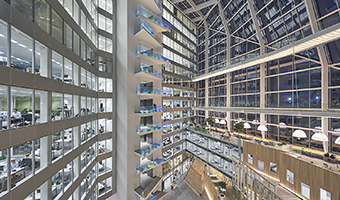Evolving working practices
The built environment has a critical role to play in motivating and attracting staff. Until recently, developers and landlords were heavily focused on building functionality and design. The introduction of BREEAM in 1990 was the first major step change in the construction process, setting best practice standards for the environmental performance of buildings and becoming somewhat of an industry benchmark.
Since then, property betterment has become a primary relocation driver, fuelled by the meteoric rise in Corporate Social Responsibility, which has pushed social, economic and environmental considerations up the business agenda.
Rapid technological advances and new generations entering the workforce has driven new ways of working, and businesses have now begun to turn their attentions to the link between their employees’ physical and mental wellbeing and productivity.
Not only do they have a duty of care to their employees to take all steps which are reasonably possible to ensure their health, safety and wellbeing, workplace wellness is also becoming a source of competitive advantage, both in terms of brand awareness, talent acquisition and staff retention.
Defining wellness
As a concept, ‘wellness’ is relatively new and there is still considerable ambiguity around the definition, usage and function of the word. At its most basic level, wellness can be defined as a “state of being in good health, especially as an actively pursued goal”. However, it is intangible, difficult to define and even harder to measure. This makes developing and even identifying buildings that promote workplace wellness a challenging task.
The WELL Building Standard® was introduced by the International WELL Building Institute (IWBI) in October 2014 as an evidence-based system for measuring, certifying and monitoring the performance of building features that impact health and wellbeing.
Focusing on seven categories of Air, Water, Nourishment, Light, Fitness, Comfort and Mind, WELL identifies a series of performance metrics, design strategies, and procedures that can be implemented to improve building occupant health and wellbeing.
The intentions for each of the seven categories are listed below:
AIR |
Optimising indoor air quality to support the health and well-being of building occupants |
WATER |
Promoting safe and clean water through proper filtration and other methods |
NOURISHMENT |
Availability of fresh, wholesome foods to encourage better eating habits |
LIGHT |
Minimising disruption to the body’s circadian system through requirements for window performance and design |
FITNESS |
Integrating exercise and fitness into everyday life by providing the physical features and components to support an active and healthy lifestyle |
COMFORT |
Establishing requirements designed to create a distraction-free, productive and comfortable indoor environment |
MIND |
Incorporating design, technology and treatment strategies designed to provide a physical environment that optimises cognitive and emotional health |
From a practical perspective, this means that businesses are able to assess and compare a building’s wellness quality against measurable criteria, allowing them to make informed decisions about their future property strategy.
For landlords, the return on investment will come from differentiation; attracting the highest-quality tenants will enable them to command premium rents, increase their property values and reduce potential void risks.
Race to the top?
Despite these far-reaching benefits, in the three years since its introduction, a mere 34 projects across the UK totalling circa 7.2m sq ft of office space have been registered, only four of which have reached certification status.
Globally, there are just-under 900 WELL Building projects; the majority of which are, unsurprisingly, located in the United States and China.
Caroline Waldron, Senior Surveyor in LSH’s Office Advisory division, believes the reason so few buildings have achieved certification to date is because of the extensive nature of the requirements and associated costs, rather than a lack of occupier demand. She commented: “Cultivating employee wellbeing within the office environment is becoming increasingly important, not only in terms of the individuals themselves but also the company as a whole. However, there are no fixed costs when it comes to incorporating the required elements to meet the WELL Building Standard, making it a substantial investment. Businesses need to balance the long and short-term objectives of achieving the WELL Building Standard against their often restricted budgets. Recipients of the Standard are also required to continuously demonstrate their compliance by measuring and documenting all of its performance metrics which also makes it quite onerous from an occupier’s perspective. If WELL Buildings are to take-off in the UK, it’s likely that landlords will need to be the driving force behind them.”
So the question is, from the built environment’s perspective, will landlords see this as a passing fad or will the WELL Building Standard® become a primary consideration to all future office developments?
Landid and Brockton, the developer behind the Porter Building in Slough - the first in the UK to achieve Well Core and Shell certification - believes that in five years, every new office building will be seeking a WELL certification.
Chris Hiatt, Director at Landid, commented: “Landid has always been at the forefront of sustainability best practice within the built environment so, when we heard about the WELL Building Standard, it seemed like the next logistical step for us.
“Yes, we’ve taken on an element of risk but, when you think back to when BREEAM was first introduced, there was a great deal of debate about its value and now it’s common practice across all major developments. From the research we’ve seen from the International WELL Building Institute, the conversations we’ve been having with occupiers and the fund interest we’ve received since launching the building, we’re confident that this will be the same. Therefore, anything we can do to support it, whether by making the WELL Building Standard a core feature of all our future developments, or by simply raising the debate, makes total sense.”
A collaborative approach
The physical and mental impact of the workplace on employees is undeniable and the focus seems to be very much on developers to lead the charge in effecting change. However, it’s important to note that workplace wellness only really gets underway when the building becomes occupied, so businesses too, have a crucial role to play.
Through proactive collaboration, the two can foster an environment where workplace wellness can flourish, bringing with it a whole raft of benefits and that marks a real step change in the way buildings are not only developed, but also occupied.
For a detailed guide on office costs for over 50 UK locations, view our latest Total Office Costs Survey.
REGISTER FOR UPDATES
Get the latest insight, event invites and commercial properties by email








